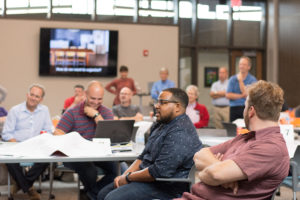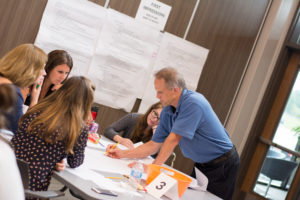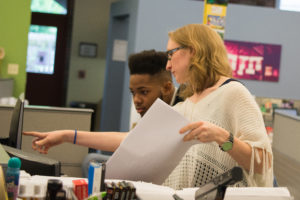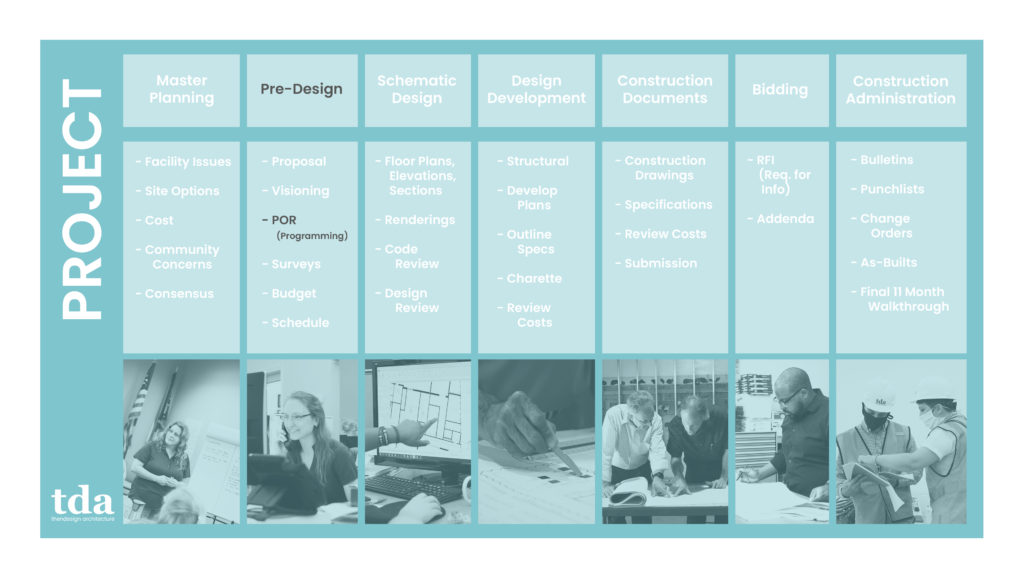The architectural design process is intense and spans months, with designers considering a building from many perspectives. Naturally, many of our clients ask, “What is the most important aspect of designing such a big building?”
The answer surprises most of our clients.
A foundational element of building design isn’t in the architectural drafting, detailing or 3D modeling. It’s not in the problem solving sessions or even a thorough and detailed understanding of construction techniques. Those are all significant, but the most important aspect begins well before a building is considered. It is realized early on in the design process and revealed in simple conversations, it’s known as “Architectural Programming.”
Abby Rainieri is the Educational Design Lead at ThenDesign Architecture and regularly engages with districts and architects in the pre-design phase called “Architectural Programming.” Having completed many successful projects, she has developed flexible processes for this phase that include determining project funding, community surveys, public engagement and OFCC design compliance.
Abby recounts, “Many times, our clients come to us, not even knowing what to ask for. This leads us to help them discover what they need and what to ask for. We call it “problem seeking.” It’s a lot of listening, data collecting, assessing a facility and trying to understand the problems they are trying to solve. We encourage conversations and explore multiple solutions with the goal of putting projects on an overall path to success. A lot of the biggest things we need to grapple with as we move into programming and schematic design are established in early planning conversations about the project. It sets the tone for the rest of the design process.”
Design Phases Simplified:
Master Planning and Architectural Programming
“Master Planning” proceeds “Programming” and is also a crucial time for conversation. During “Master Planning,” we seek to understand the unique educational needs of a school district, the condition of their existing facilities, their budgetary needs and any other curriculum requirements. Armed with this context, we have an all-encompassing understanding of who the project will serve. Only then, can we begin programming.
To better grasp “architectural programming,” consider how computer programming works. Software designers need to consider how a proposed program should work, then write the complicated computer code to allow it to function. Throughout this process, they consider how an “end user” ultimately experiences that program and are responsible for making sure the features work for a wide variety of users. When updates are needed, they ensure these additions work cohesively with the existing software.
“Architectural programming” is quite similar. Early in the process, architects and designers work with future building users, clients and stakeholders to understand the features and functions desired for the finished building. Keeping in mind user experience, they create a list of ingredients, (square footage and spaces) that will make up the new building.
At this point, we aren’t even considering a building yet. We are brainstorming and talking through how the building should function in the future and its role in the community. We imagine the key activities inside and ensure enough space is allocated for those purposes. It’s only then that we can start to think about architecture. Once we have a clear idea for how the building should function and a list of needed spaces and their square footage to accomplish these functions, then we can start to think about architectural forms and materials.
The more effort put into the programming phase, the more likely the project emerges successful.
“As we [document necessary spaces] we move into engagement and work sessions. Our “Educational Visioning Sessions,” are a piece of this, along with staff engagement. We take different user groups or a core team on tours of new buildings, so they can see how other districts have solved space problems. In this initial concept phase, we are getting further into planning and feedback. After that, we begin the traditional kind of architectural process of making diagrams and drawing plan iterations, then continue engagement with the community, the board and the staff.”
OFCC and Project Funding
How each project is funded also plays an integral role in the building process. Many districts find that partnering with the OFCC (Ohio Facilities Construction Commission) allows them to receive financial assistance and be able to build structures that would have been out of reach if they tried to do it alone.
Since 1999, the OFCC has provided over $700 million to districts across Ohio and has been involved in opening over 1,200 new or renovated school buildings. This is a common way districts pursue state funding based on their needs for future facilities. However, rarely does the OFCC fund a project in its entirety. District administrators still need to convince voters to approve school construction bond tax hikes to cover some building construction costs.
How does this impact the programming design phase? In order to qualify for assistance, the school design must follow guidelines directly from the OFCC to ensure the educational needs of the building are met. These guidelines come in the form of a “Program of Requirements” guideline or PORs. The POR is essentially a checklist of spaces and square footage that need to be allocated inside the building. Since each district is different, there are a number of POR options to consider. One option is a “Traditional POR.” This is the most rigid in terms of square footage and spacial requirements, another option is a “Partial Order Reduction POR,” this allows some flexibility in spatial requirements and allocating square footage. Another type of POR is the “High Performance Learning Environment (HPLE) POR” which gives the most flexibility in the design of educational spaces. However this plan needs to be accompanied by rigorous curriculum documentation and support from the district with professional development for teachers which include plans on how to use the spaces in their new curriculum. While flexible in design, this requires the most district planning early on to ensure the new space will work for students.
PORs directly influence architectural design, since they are the starting point–a list of spaces and square footages which need to be included in the building. It is the job of a creative designer to make the most of these spaces within the district’s given budget.
Engaged Learning Environments
“Within the traditional POR, there have been times when districts wanted to create extended learning areas. They wanted to create collaborative learning areas, but they’re not going to go through a documentation and educational visioning process for an HPLE. (Imagine a spectrum of traditional PORs on the left and contemporary student centered learning (HLPE PORs) on the right, some districts may fall in the middle of that spectrum.) We can work within the Traditional POR to make some extended learning spaces.
For the last five to ten years, a lot of districts have wanted to create extended learning areas or flexible learning spaces in their buildings. Since there wasn’t always a vehicle to do that within the “Traditional POR,” we carved away 10% chunks of some of the academic spaces, we’d gather those chunks up in what we called “donor square footage” and we would create those other types of learning spaces that they wanted. There are ways to manipulate and move within the Traditional POR and still design unique learning environments. Another example is to move the space dedicated to a media center or computer lab into classrooms or to other collaborative spaces, so students wouldn’t be confined to a central area but could access these resources in their classrooms. So, there is some flexibility in these plans, all of this planning and initial design takes place during architectural programming.”
Even though the OFCC is known for assisting with funding for public projects, they also help with comprehensive guidance throughout the project, from groundbreakings, to the demolition of old facilities, then to the completion and opening of the new building. They have resources to help smaller districts complete a large project such as a new school building.
“In order to ensure spaces are compliant with the OFCC standards, the architect partners with the OFCC, particularly in the early phases of design. “There’s either going to be a project administrator from the OFCC an OFCC planner, or what’s called an RPC (a Regional Programming Consultant) to check in on progress. So they’re essentially acting as eyes to review and make sure you’re following all the OFCC requirements. They’re the ones that are going to review square footages, and your overall building square footage once we start submitting drawings, to make sure you meeting requirements.”
Open Collaborative Learning Environments:
Architectural Programming: How a School Building is Designed
Having been through the programming phase many times as a registered architect, Abby places a huge important on this initial phase of design. “Technically, programming is establishing the spatial relationships, quantities and functional solutions for an end user.
As architects and designers, I think sometimes, we are too eager to jump into architecture. Sometimes the building owners are too. They’re excited, they want to see pretty pictures and almost immediately want to start planning a groundbreaking ceremony. However, if we set up an approach to program the building intentionally and with an open mind, we setup the successful integration between defining all the necessary spaces and the schematic design. We can create the best, most useful and interesting spaces this way. So that’s why I think architectural programming is so important.”
The design phase “programming” is key to a successful project. In this phase the architect, district, and community can imagine (or reimagine) what their building should be. Without being bound by costs, or materials, they can think broadly about how this structure can function, improving the lives of the community and students. Then armed with a list of spaces and square footage, the designer begins laying out diagrams to show relationships between spaces-which are the beginnings of successful architecture.
“Most of those actions, that I just described really don’t have anything to do with architecture. They integrate nicely with it, when we’re ready to go there. But it’s important to recognize how much of it is about communication and gathering and analyzing data. Then with the understanding that this is all K-12 architecture, ultimately we get to design something that serves kids and young people. I mean, come on, that’s just the coolest thing–and why I do this.”
Key Takeaways:
- The pre-design phase know as "Architectural Programming," is a time for conversations focused on how the future space should work.
- Conversations between the architect, owner and district are the key to success.
- When working with the OFCC, their guidelines will affect what spaces are included in the final building.
- As "Architectural Programming" is completed, architects build a list of necessary spaces and square footages for the building. From this information, they create diagrams noting the relationships between spaces.
- This pre-design phase sets the tone for the rest of the project. Ideas and needs from these conversations will be "programmed" into the future building.



Let’s work together to make education better. Interested in speaking with us? Get in touch!

Ryan Caswell
Communications

Ryan Caswell
Communications
Get our newsletter with insights, events and tips.
